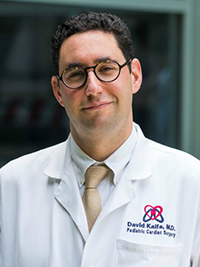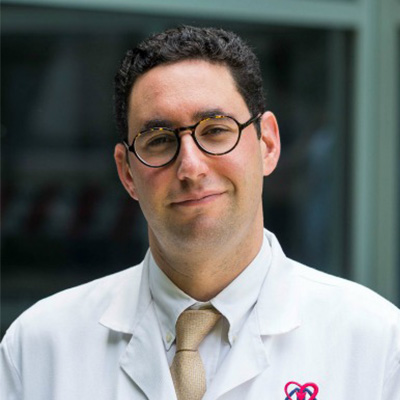“There's nothing better than bringing new life to children, fixing their hearts, and watching them flourish,” says David M. Kalfa, MD, PhD, Director of the Pediatric Heart Valve Center and Surgical Director of the Initiative for Pediatric Cardiac Innovation at NewYork-Presbyterian/
Dr. David Kalfa
As a board-certified cardiothoracic surgeon with a sub-specialization in pediatric cardiac surgery, Dr. Kalfa has a clinical practice encompassing both pediatric and adult patients who present with either congenital or acquired heart disease. Each year, Dr. Kalfa and his surgical colleagues in the Congenital Heart Center at NewYork-Presbyterian perform more than 70 tricuspid valve repairs on children with Ebstein’s anomaly and other tricuspid valve disorders. As these children transition to adulthood, techniques to correct anomalies in the young can fail over time, and as adults, they will likely face additional surgery to replace their native valve with a mechanical or bioprosthetic valve.
As a translational researcher, Dr. Kalfa has a dedicated lab focused on developing mechanical engineering and tissue engineering approaches to improve the clinical outcomes and quality of life of children with congenital heart defects. “My lab is seeking to develop new devices and innovative solutions to improve the care that we can provide to children and adults with congenital heart valve malformations,” says Dr. Kalfa.
Among Dr. Kalfa’s recent research endeavors is a retrospective analysis of outcomes in patients, ages 12 to 53 years of age, with non-Ebstein 2-ventricle congenital tricuspid valve disease who had isolated tricuspid valve surgery at NewYork-Presbyterian/Columbia. Dr. Kalfa and his colleagues sought to address the absence of data on surgical indications, outcomes, and prognostic factors related to tricuspid valve surgery for patients with congenital tricuspid valve disease overall. Study data is particularly scarce in patients who do not have Ebstein or single-ventricle lesions and for those patients with lesions related to congenitally corrected transposition of the great arteries.
Dr. David Kalfa and his colleagues sought to address the absence of data that could classify surgical indications, report on outcomes, and identify prognostic factors related to tricuspid valve surgery for patients with congenital tricuspid valve disease overall.
The research team, comprised of adult and pediatric cardiac surgeons from NewYork-Presbyterian/
- 72 patients (84.7 percent) had a cardiac malformation present
- 80 patients (94.1 percent) had isolated tricuspid valve regurgitation (TR)
- 3 patients (3.5 percent) had isolated tricuspid stenosis (TS)
- 2 patients (2.4 percent) had mixed TR and TS
- 52 patients (61.2 percent) had a history of a previous cardiac surgery
- 66 patients (77.6 percent) underwent TV repair; 19 patients (22.4 percent) had TV replacement – all with a bioprosthetic valve implanted
- 84 patients (98.9 percent) had an additional procedure performed at the time of the TV intervention, including the most common atrial septal defect repair, followed by pulmonary valve replacement, pulmonary artery plasty, and ventricular septal defect repair
The study, published in the July 4, 2022, issue of JTCVS Open, showed:
- A median length of ICU stay of 2 days and a median length of hospital stay of 6 days
- Patients undergoing TV repair were significantly younger (age 29 versus 53 years) and smaller by body surface area
- Older patients had significantly more isolated TR and less TS
- Older patients were more likely to undergo TV replacement (29.9 percent versus 0.0 percent for those younger than age 12)
- Patients younger than 12 were at higher risk for re-intervention or recurrent TR, and preoperative mitral regurgitation deemed moderate or greater increased this risk, especially in patients older than 12
- While TV repair was performed more commonly in younger patients, no difference in outcomes was found between patients undergoing TV replacement versus repair
Based on the results of the NewYork-Presbyterian/





